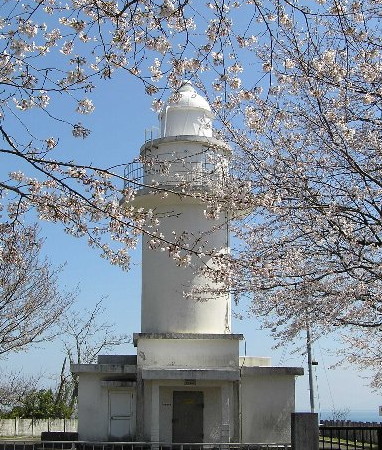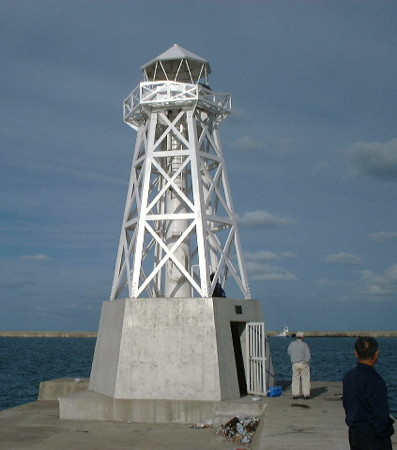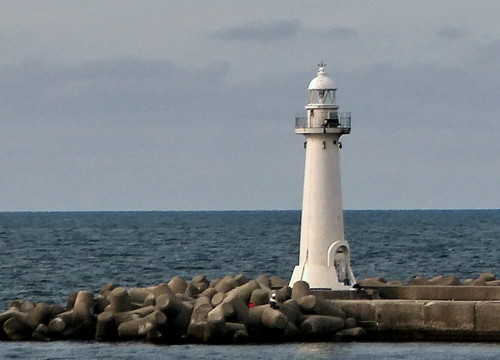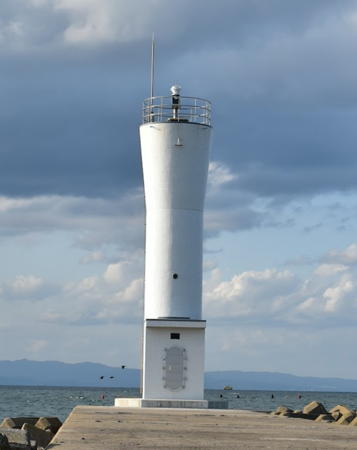The nation of Japan, known in Japanese as Nihon or Nippon (日本), occupies an archipelago off the east coast of Asia. The four main islands are Hokkaidō in the north, Honshū (the largest) in the center, Shikoku in the south, and Kyūshū in the southwest. The country includes thousands of other islands of all sizes; among them the Ryūkyū (Nansei) Islands are a long chain extending to the southwest and including the large island of Okinawa, and the Nanpō Islands are another long chain extending south into the Pacific Ocean. Much of Japan is mountainous but the coastal regions are densely populated and urbanized; the country's population is about 126 million.
Japan is divided into 47 prefectures. This page lists lighthouses of Toyama Prefecture on the western coast of Honshū. Toyama Prefecture faces north on Toyama Bay, a broad inlet of the Sea of Japan partially sheltered on the west by the mountainous Noto Peninsula in neighboring Ishikawa Prefecture. Unlike most Japanese coasts the coast of Toyama Bay is relatively low, with only a few rocky promontories.
In Japanese the word for a lighthouse is tōdai or toudai (灯台). The words saki and misaki are for capes and headlands, hana ("nose") is a promontory, hantō is a peninsula, shima (also spelled sima or jima) is an island, bae is a reef, iwa or shi is a rocky reef, amase or se is a shoal, wan is a bay, nada is a sound or basin, kaikyō is a strait, kawa is a river, and kō or minato is a harbor.
Lighthouses in Japan are operated and maintained by the Japanese Coast Guard's Maritime Safety Agency. On Honshū there is at least one Coast Guard Section Office in each prefecture, often two or more. Toyama Prefecture has a single office at Fushiki.
A note on the Sea of Japan/East Sea controversy: The Directory takes no side in any international dispute; it makes use of the terminology, names, and spellings as they currently exist in each area covered. The sea between Japan and Korea is called the Sea of Japan on the pages for Japan and the East Sea on the pages for Korea.
ARLHS numbers are from the ARLHS World List of Lights. JCG numbers are the Japanese Coast Guard's light list numbers. Admiralty numbers are from volume M of the Admiralty List of Lights & Fog Signals. U.S. NGA List numbers are from Publication 112.
- General Sources
- Lighthouses in Japan - Toyama
- A comprehensive site covering the major lighthouses.
- Lighthouse-Japan.com - Toyama
- Excellent photos with notes (in Japanese) for most of the lighthouses.
- Form of a Lighthouse - Toyama
- Another site with many photos of Japanese lighthouses; this source is cited below as FOAL.
- Lighthouse Visit
- Another good source of lighthouse photos.
- Online List of Lights - Japan
- Photos by various photographers posted by Alexander Trabas.
- Misty's Japanese Lighthouse Tour - Toyama
- Photos and a few notes for lighthouses in all parts of the country.
- Lighthouses in Toyama Prefecture
- Photos by various photographers available from Wikimedia.
- World of Lighthouses - Japan
- Photos by various photographers available from Lightphotos.net.
- Ninth Region Lighthouse Location Map
- This interactive map links to photos and descriptions (in Japanese) of the major lighthouses of the Ninth Coast Guard Region, including Ishikawa, Toyama, and Niigata Prefectures.
- Navionics Charts
- Navigation chart for western Honshū.

Iwasaki No Hana Light, Takaoka, April 2012
Japanese Coast Guard Fushiki Office photo (no longer online)





